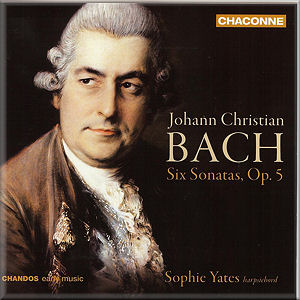 |
 |
|


alternatively
CD: Crotchet
Download: Classicsonline
|
Johann Christian
BACH (1735-1782)
Sonata I, Op.5 No.1, in B-flat major W:A1 [8:31]
Sonata II, Op.5 No.2, in D major W:A2 [14:00]
Sonata III, Op.5 No.3, in G major W:A3 [11:03]
Sonata IV, Op.5 No.4, in E-flat major W:A4 [11:28]
Sonata V, Op.5 No.5, in E major W:A5 [11:14]
Sonata VI, Op.5 No.6, in C minor W:A1 [10:54]
 Sophie Yates (harpsichord) Sophie Yates (harpsichord)
rec. 28-29 November 2005, St George’s, Brandon Hill, Bristol.
 CHANDOS CHACONNE CHAN0762 [67:48] CHANDOS CHACONNE CHAN0762 [67:48]  |
|
|
Sophie Yates’ informative and well written
notes for this release sum up J.C. Bach’s artistic circumstances
in London succinctly. She mentions his alternative route in
music away from the more dramatic empfindsamer style
of his elder brother and teacher Carl Phillipp Emanuel. The musical kinship
which Mozart apparently felt for J.C. Bach is mentioned, and Mozart’s
own style can certainly be heard in aspects of these Op.5 Sonatas. Yates also
states the
position of the harpsichord alongside that of the piano - both instruments
existing with more or less equal popularity at the end of the eighteenth century.
Bach
would have used both but Yates prefers the harpsichord, feeling that the freshness
of the ideas are shown to greater advantage: “Whilst we cannot put ourselves
in the place of an eighteenth-century audience and experience Bach’s
new Mannheim mannerisms with quite the shock that they might have felt, the
harpsichord
can provide a musical context in which the novelty of the writing retains its
originality.” The same case might be made for a well-made fortepiano,
but Sophie Yates’s persuasive performances transcend any such a pointless
ping-pong argument.
The ‘London’ or ‘English’ Bach’s position in musical
and geographical history to me always seems to put him at something of a disadvantage.
As a Bach somewhat out of place and time, the impression many people might have
is of a composer making a living producing work acceptable to the almost allergic
sensitivities of his frill-clad audiences - work which falls between the towering
Baroque genius of his father, and below the towering Classical genius of Mozart.
Experts may have revised scholarly opinion in this area, but it takes recordings
like this to show the rest of us just what we’ve been missing when it
comes to J.C. Bach. Starting with the playful two-part invention which opens
the Sonata
I, it may take a little while for the ear to grow accustomed to the subtle
variations which turn a superficially simple and diatonic idiom into something
rich and fascinating. Sometimes it takes an attempt at playing pieces like this
to reveal the magic, but even looking from the outside in you can let your ears
follow bass lines which turn a corner less expected, or a melody which leaps
onto a different plane or swoops and dives like the flight of a swallow. These
pieces are not without their moments of intensity and drama. Follow the innocent
opening of Sonata III, and I guarantee you won’t fail to be impressed
by the directions the music follows - at once filled with melodic and harmonic
elegance and surprise, and delivering plenty of impact in some of the sequences
which follow, with their remarkable modulations and subtle chromatic inflections.
Those melodic leaps are deliciously manifested in the slow movement of this
sonata, and I would point to the Rondeaux of Sonata IV for another toothsome
cake filled with stunningly characteristic layers. Yes, there are plenty of alberti
basses going on underneath all that melodic charm, but these are always restless;
wandering off their supposedly allotted harmonic paths like errant children,
always testing and trying new things. Virtuoso playing can be found in the chasing
runs of Sonata V’s Allegro assai and Prestissimo outer
movements, and changes in colour can also be found here in the damped strings
of the central Adagio. The climax of the programme is the Sonata VI which
is the most forward-looking of the set. Yates points out the almost Sturm
und Drang feel of some moments in the first movement to this sonata, even
more surprisingly set next to a fugal second movement designed to titillate
the London taste for ‘ancient music’. The sonata closes with the
more personal sentiments of an Allegretto, whose wistful descending
motives encourage an atmosphere of refined, intellectual thoughtfulness.
Sophie Yates has already recorded a number of critically acclaimed CDs for
the Chandos label, and this rewarding release is richly deserving of equal
status.
The harpsichord sound is rich and non-fatiguing, and you would have to have
a serious harpsichord allergy not to be able to listen to and appreciate the
music
and these wonderful performances beyond any negative predisposition for plucked
resonance. The recording is stunning: detailed and spacious at the same time,
a real delight. Sophie Yates’s strength, beyond superlative technique,
is in allowing the voice of the composer to speak with a directness and clarity
which is unaffected and natural. J.C. has a glint in his eye on the cover of
this CD, and Sophie looks out at us from the back of the booklet with a look
filled with comparable intelligence and wit. These are two artists connected
by comparable creative sensitivity, and the evidence is clear from the music
on this excellent CD.
Dominy Clements
|
|

